Women, Wine, and Watching from the Window
The Woman in the House Across the Street from the Girl in the Window wears it’s inspirations on its sleeve. Directly spoofing both 2016’s The Girl on the Train and 2021’s The Woman in the Window, the Netflix series follows Anna (Kristen Bell), a troubled woman who drunkenly witnesses a murder in the house across the street. Having essentially withdrawn from life after the death of her young daughter, Anna must fight to be taken seriously in a world she no longer wants a place in. It’s an oversimplified amalgam of the aforementioned films, in which Rachel (Emily Blunt) and another Anna (Amy Adams) struggle to engage with the world after their lives are shattered by tragedy. While functioning as an albeit silly murder mystery on it’s own, The Woman essentially cements a burgeoning sub-sub genre of psychological thrillers. Not quite “good for her,” but more complicated than “believe women,” they exist as examinations of societal standards for domestic perfection and the dangers of internalized inferiority.
Anna (Bell) is a lonely woman who spends her days drinking glass after glass of red wine from an armchair by the window. Her husband has left her for (among other things) occasionally speaking in a British accent. She also keeps forgetting that her 9 year-old daughter is dead, eaten by a cannibal named Massacre Mike (Brendan Jennings) when her FBI profiler husband left her alone with him on Bring Your Daughter to Work Day. She naturally blames herself for the tragedy and has developed a debilitating fear of rain due to the stormy weather on the day of her death. When she witnesses a murder in the house across the street, owned by dreamy new neighbor Neil (Tom Riley), she reports the crime and begins an investigation into his past. Hoping to reclaim her perfect life, she explores the possibility of a new relationship with him while forming a maternal attachment to his daughter. The bones of the plot are both familiar and relatable with genuinely touching moments examining heartbreaking truths. But Anna (Bell)’s story is dramatically sanitized and oversimplified, clarifying a formula established by the other two films.
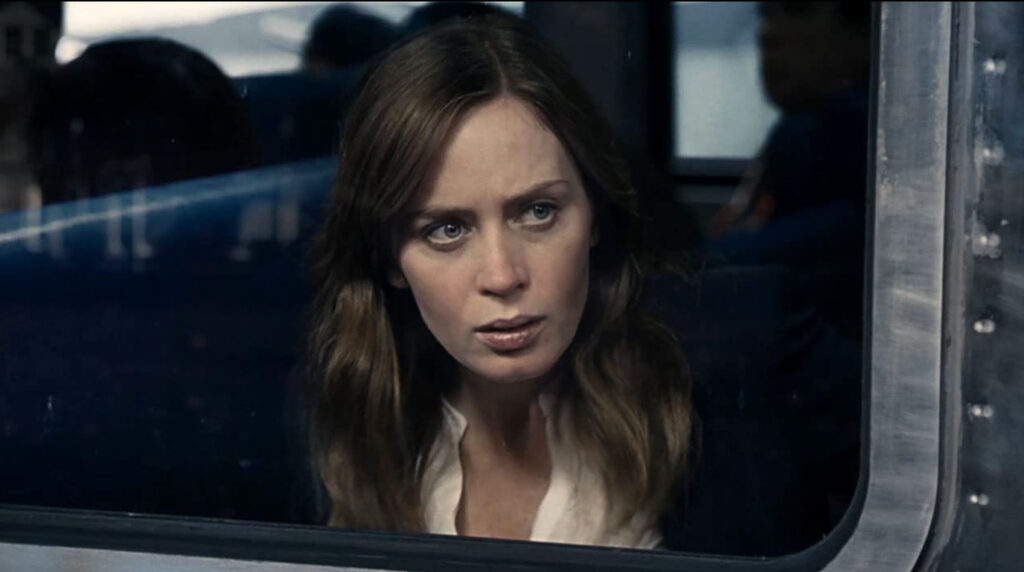
Both Anna (the Woman in the Window) and Rachel (the Girl on the Train) watch life go by from the sidelines. Rachel is divorced, having been left by her husband Tom (Justin Theroux) for another woman. After failed attempts at natural conception and IVF, her drinking has become unmanageable and she believes her erratic behavior caused him to leave. Rachel now passes her old home on the train every day and watches the perfect life she could have had unfold with someone else; the baby she desperately wanted with the man she still loves in the house she used to live in. To distract herself, she fixates on a couple who live two doors down, the lonely Megan (Haley Bennett) and her husband Scott (Luke Evans). When Meghan disappears, Rachel believes she may have a key to solving the mystery and inserts herself into the story.
Anna (Adams) is an agoraphobic counselor who lives in a New York City brownstone. Haunted by memories of her deceased husband and daughter, she spends her days drinking red wine and taking the pills prescribed by her psychiatrist. She too witnesses a murder across the street and involves herself in the story, hoping to save the couple’s teenage son. When the woman she believes she saw die appears at her door, Anna begins to doubt her sanity, dismissing the murder as a manifestation of her grief and altered judgment.
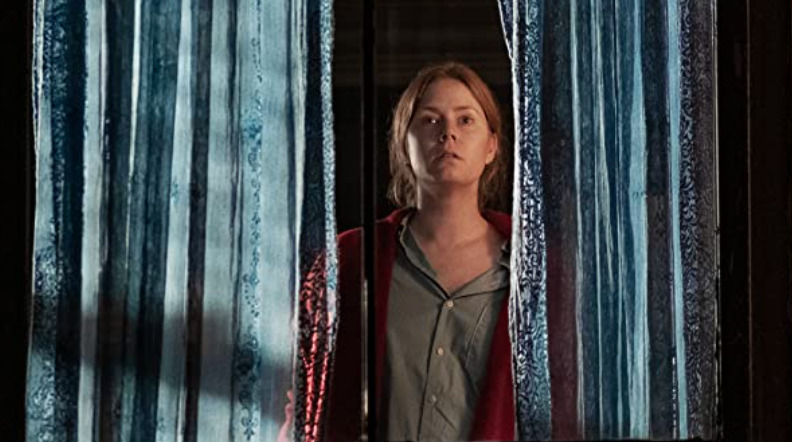
The similarities between Anna (Adams) and Rachel run deeper than the titles of their stories. Both women have withdrawn from the world and seemingly given up on happiness. Both believing they had then lost the perfect life, they see little to live for now and pass the time drowning their sorrows in alcohol. Neither seem particularly focused on their careers and define their former happiness by their status as wife and mother. But now they are single women again, detached from the world and unable to find fulfillment alone. They can’t seem to let go of the life they had and see themselves as lost causes, whiling away the days in woeful obscurity.
All of this hopelessness is exacerbated with alcohol. Featured prominently on the posters, Anna (Bell) perpetually has a large glass of red wine in tow. She’s constantly opening bottles and has a giant bowl full of discarded corks on her table. Alcohol also factors heavily in Anna (Adams)’s and Rachel’s stories as well. While Anna (Adams) also drinks large quantities of red wine, Rachel just drinks. Carrying mini bottles with her on the train, she spends most days loaded and her face bears the signs of her addiction. All three women self-medicate with alcohol to dull the pain and help them pass the lonely days. Rachel’s addiction is the most severe. Drinking now defines her life and she can barely remember the crime she witnessed or why she woke up bloody and bruised the day after Megan disappeared.
Rachel and Anna (Adams) embody the inverse of Wine Mom Culture, a fad among upper class mothers who’ve been convinced by #GirlBoss feminism that they can “have it all”. If they just lean in, they too can have the empowering career, the perfect family, the homemade baby food, and the stylishly messy house, all while finding time for yoga, meditation, and jogging in the park. With feminine expectations skyrocketing, many mothers turn to wine and pills to cope with the stress. It’s even become something of a brand complete with wine glasses labeled “Mommy Juice” and sweatshirts emblazoned with “Coffee, Wine, Repeat” It’s been normalized and even fashionable to use alcohol as a coping mechanism for the pain that comes with trying to live up to womanly perfection. What these films show is that the opposite is also true. Rachel and Anna (Adams) did “have it all.” Then they lost it. Now to cope with the pain of what they believe their lives should have been, they turn to drinking as well. This narrow view of perfect womanhood is not serving any one and only hurting the people who try to attain it.
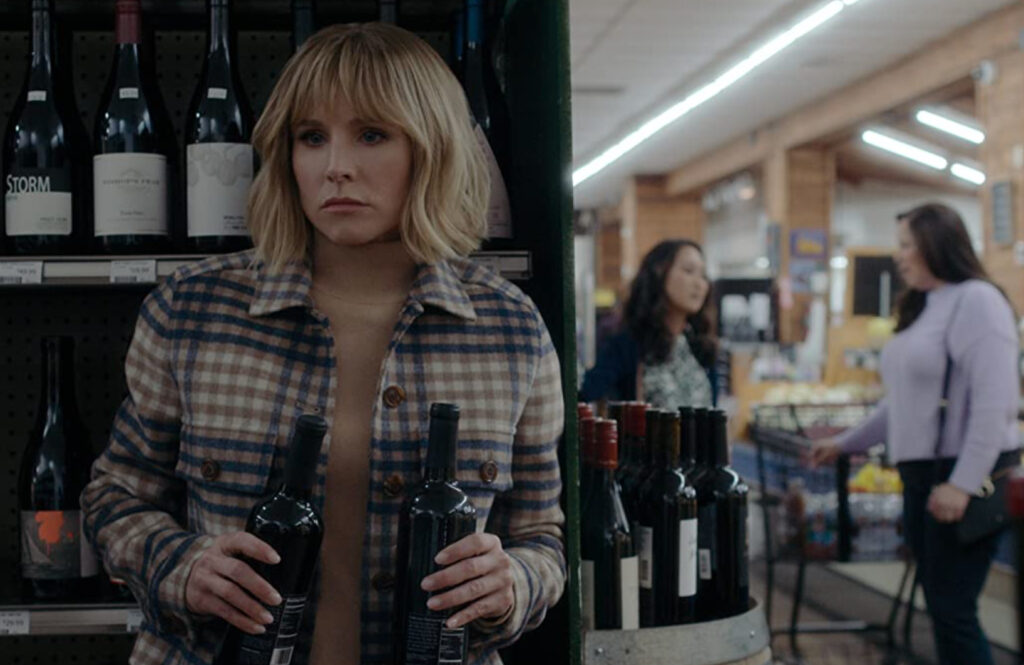
Part of their drinking comes from the fact that they see no other outlet to cope with the pain of their loss. Our cultural ideals for womanhood are so deeply ingrained that we don’t know what to do with a woman who has lost her family. Everyone views Anna (Adams) and Rachel with pity. Some do attempt to help them rejoin the world, but when presented with the tragedies of their lives, most people they encounter just look down and shuffle their feet. Instead of offering help, they excuse the women’s erratic behavior with a pitying glance and a fumbled apology. And it’s not like Anna (Adams) and Rachel reach out themselves. The shame of what they lost and who they are now seems to dwarf even the pity from others. They withdraw from the world and resist the support that could actually help them.
It’s Anna (Bell) who tells the truth about this hesitancy to change. While sharing in a grief support group, she realizes that she’s been reluctant to move on because the pain keeps her close to the memory of her daughter. If she can stay lost in her grief, maybe she doesn’t have to believe that her daughter is actually gone. This is also what seems to keep Rachel and Anna (Adams) stuck. They don’t want to accept what was lost because it makes them feel like failures. They don’t want to move on because it means they can no longer keep punishing themselves. Rachel keeps coming back to the house, trying to relive her past life. And Anna plans to kill herself, sobbing that what she really wants is the impossibility of being forgiven. They don’t want new lives because they don’t believe they deserve them.
Rachel and Anna (Adams) both blame themselves for what they’ve lost. This is brought humorously to life when Anna (Bell) blames herself for reminding her husband that it’s Bring Your Daughter to Work Day. While this sets off a chain of events that leads to her daughter’s death, she is in no way responsible for the tragedy. Anna (Adams) blames herself for the car accident that killed her daughter and husband. Though she was distracted on a snowy road, she did not intentionally crash the car. But she shifted her eyes from the road to keep her husband from seeing a call from her lover and believes that her infidelity is proof of her failure as a wife and mother and thus to blame for the death of her daughter. Rachel also blames herself for the demise of her marriage. Though infertility is unfortunately common, she believes her inability to handle it gracefully is what drove her husband away.
But Rachel’s husband has been lying to her, gaslighting her and convincing her of terrible things she did while drunk to distract from his awful behavior. She has done nothing wrong. Each woman feels guilt because of normal human flaws. This condemnation stems from the cultural tradition of seeing women as responsible for the household. All three women blame themselves for unpredictable tragedies because they see themselves as ultimately responsible for their family’s survival. Though they’ve each made mistakes they regret, the only thing they’ve failed at is living up to the impossible expectations society sets for women. Like Tom, our patriarchal culture gaslights women by expecting perfection no matter the circumstances. Those who cannot live up to these impossible demands are cast out of society and regulated to the wine soaked shadows.
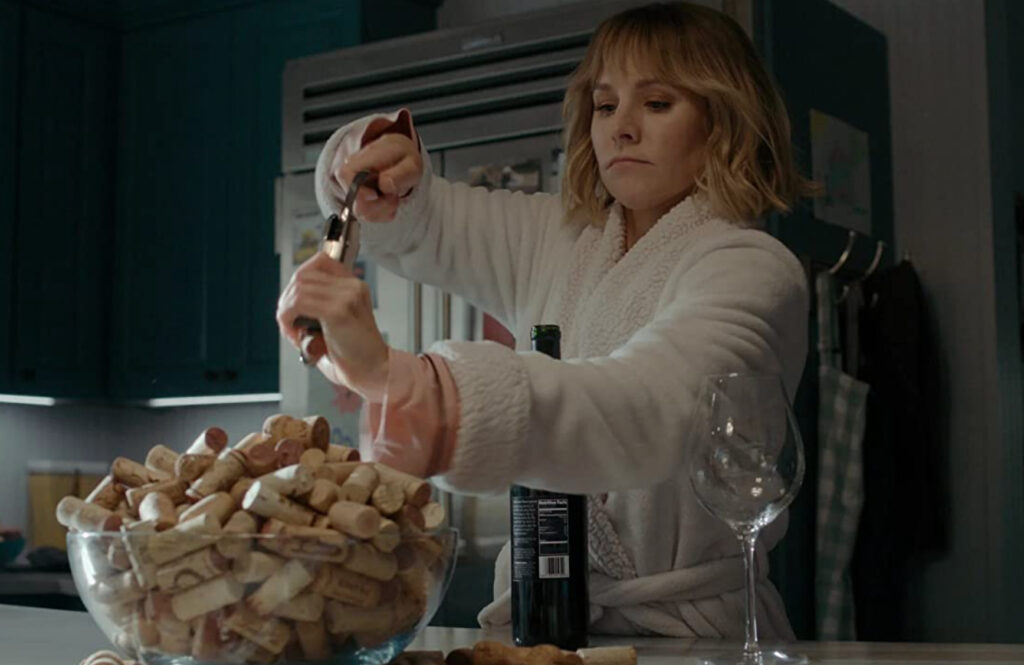
It’s a story I know well. I’m now in recovery, but for years I drank to escape the pain of my own perceived failure. Desperate to keep up with all of my married friends, I began dating a questionable man and convinced myself I could change him into my perfect prince. Though he was sober when our relationship began, he quickly relapsed and I blamed myself for not being strong enough to help him. For two years we lived together in stress, aware that the relationship was bad for both of us but neither of us knowing how to escape. He descended into his addictions, and I bounced between cleaning up his messes and drinking to distract myself from the pain.
When I became pregnant, we decided to get married. I was excited to finally have my “perfect life” and convinced myself that a baby would make everything better. But three weeks before the wedding, I suffered a miscarriage. While this is unfortunately common, I was devastated. I blamed myself for failing to keep my baby alive and vowed to “fix it” by getting pregnant again. We continued plans for the wedding mostly because I was terrified of the shame calling it off would bring. I couldn’t admit to myself that the pregnancy was the only reason he’d agreed to marry me in the first place. And I’d just lost a baby. I wasn’t going to also lose a husband. But the marriage was doomed from the start. We lasted 11 months before his drinking and abuse finally became too much for both of us. He left and we got divorced.
Though free of my stressful marriage, this is when my drinking began to spiral. I was devastated to have lost the promising future I’d built up in my head and couldn’t stand the thought of dating again. Having already been a wife, I saw once again being “just a girlfriend” as a personal failure. Though I didn’t miss him at all, I missed the status our marriage had provided me. I had proof that someone found me worthy of marriage. Someone had validated my womanhood and I was terrified that no one ever would again. Without anyone to come home to or take care of, my drinking spun out of control threatening my job and friendships. I was Rachel. I was Anna. Desperately trying to hold onto life while simultaneously believing that I didn’t deserve to be part of it anymore. I had tried to be the only thing I’d ever believed I should be, a wife and mother. And I had failed. There was nothing else left for me.
It was through marriage to my second husband and becoming pregnant again that I finally pulled myself out of addiction. Someone else had found me worthy of love and it became easier for me to see myself with compassion. All three women do eventually get help and begin to live their lives again. Though Anna (Adams) is not suffering from an addiction, she changes medication and finds a way to leave the past behind. She moves to a new house and ventures outside on her own for the first time. Rachel’s recovery is less clear. In the film’s climax she refuses a drink, suggesting a desire to quit altogether. The final scene shows her sitting on the opposite side of the train and refusing to be consumed with the lives of others. Though she does go to an AA meeting, it’s only once and early in the film. I wish it were as easy as simply deciding to get better.
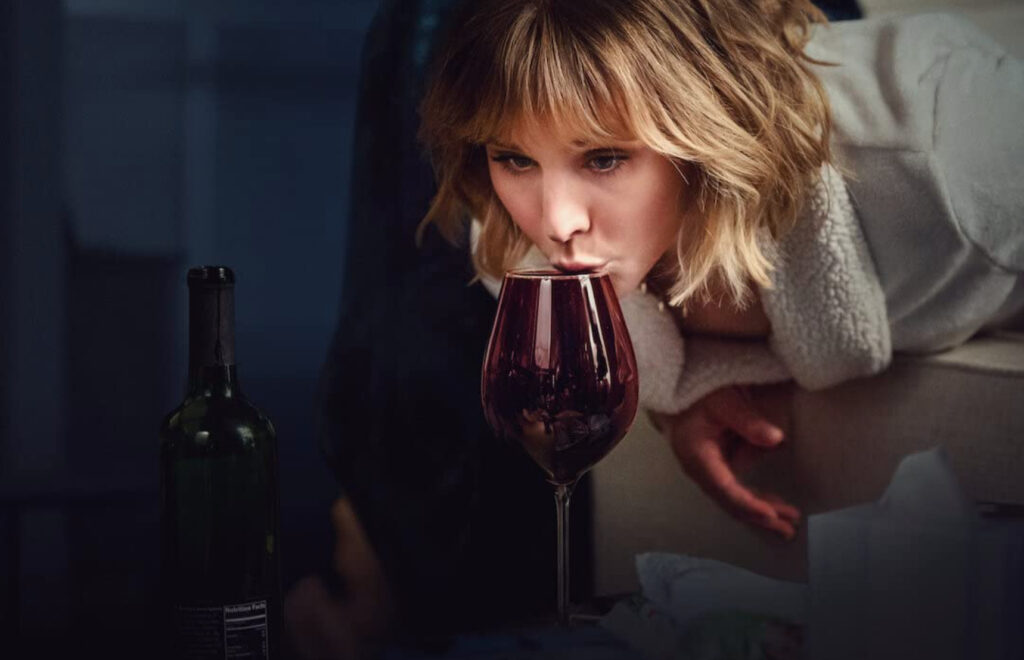
This oversimplification is brought glaringly into perspective with Anna (Bell). After deciding to get sober, she pours bottle after bottle of wine down the sink and dumps a pharmacy worth of pills down her drain. Though making the decision to get help is usually the first step to healing, Anna (Bell)’s sudden turn into sobriety highlights the oversimplified lens through which both films view recovery. Though meant to be empowering, these films gloss over a complicated journey and discount the hard work of staying sober. And though the visual of dumping pills down the drain is striking, switching medication is a long and often painful process. Many medications can have dangerous side effects if quit cold turkey and should only be discontinued with guidance from a professional. Anna (Bell) spends more time reupholstering her wine-stained armchair than she does actually addressing the addictions and maladaptive behaviors in her life.
I did get clean after meeting a loving and supportive man who wanted to help me. He’s not the only reason I stopped drinking, but the fact that he loved me even after seeing me at my worst gave me the strength to try to love myself. Ten years into our marriage, I’m still dealing with a lot of the reasons I drank but his support helps me want to keep going. This is what seemingly turns the tide for Anna (Adams) and Rachel as well. They both receive apologies and public acknowledgement that they were right all along. Though it’s not the validation they were looking for, it is recognition of their humanity. The apologies may be for ignoring the crimes they initially reported, but they feel like apologies for expecting them to be perfect. They receive compassion without pity and it empowers them to stop looking at themselves through the lens of failure.
It’s hard to find a solution for such a complicated situation. The responsibilities and expectations placed on women are foundational to the society we live in. But Anna (Bell), Anna (Adams), and Racel are living proof that women who fail to live up to these impossible standards are still deserving of humanity. All women are. Perhaps if we can let go of the classifications society uses to divide us, we can put the wine glasses down and begin to see how much we all have in common. Regardless of our stations in life, all women face the same limiting stereotypes and impossible expectations. From both sides of the window, we watch each other and feel like we don’t measure up. We brand ourselves as failures for the crime of being human and we cast those who falter aside for fear that we might find ourselves there one day too. But there is hope. If we can let go of who we’ve been told we should be, maybe we can find the strength to love ourselves for who we actually are. Rather than spending our time longing for what we see through the window, maybe we can find a way to love who we see in the mirror.
Jenn Adams